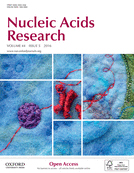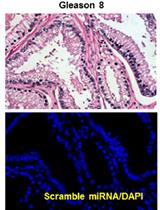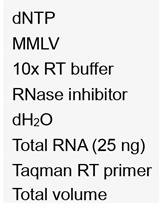- EN - English
- CN - 中文
Polysome Fractionation to Analyze mRNA Distribution Profiles
多聚核糖体分馏分析mRNA分布特征
发布: 2017年02月05日第7卷第3期 DOI: 10.21769/BioProtoc.2126 浏览次数: 31298
评审: Antoine de MorreeAnonymous reviewer(s)
Abstract
Eukaryotic cells adapt to changes in external or internal signals by precisely modulating the expression of specific gene products. The expression of protein-coding genes is controlled at the transcriptional and post-transcriptional levels. Among the latter steps, the regulation of translation is particularly important in cellular processes that require rapid changes in protein expression patterns. The translational efficiency of mRNAs is altered by RNA-binding proteins (RBPs) and noncoding (nc)RNAs such as microRNAs (Panda et al., 2014a and 2014b; Abdelmohsen et al., 2014). The impact of factors that regulate selective mRNA translation is a critical question in RNA biology. Polyribosome (polysome) fractionation analysis is a powerful method to assess the association of ribosomes with a given mRNA. It provides valuable information about the translational status of that mRNA, depending on the number of ribosomes with which they are associated, and identifies mRNAs that are not translated (Panda et al., 2016). mRNAs associated with many ribosomes form large polysomes that are predicted to be actively translated, while mRNAs associated with few or no ribosomes are expected to be translated poorly if at all. In sum, polysome fractionation analysis allows the direct determination of translation efficiencies at the level of the whole transcriptome as well as individual mRNAs.
Keywords: mRNA translation (mRNA翻译)Background
Gene expression is regulated at many steps, including gene transcription, pre-mRNA splicing, and mRNA export to the cytoplasm, turnover and translation. Given the robust impact of post-transcriptional gene regulatory mechanisms on overall protein expression patterns in the cell, there is great interest in elucidating the processes that control these events. In particular, the steady-state mRNA levels of one-half of the transcriptome show poor correlation with the level of proteins translated from these mRNAs, indicating that protein levels in the cell are potently regulated at the level of mRNA translation and/or protein stability (Schwanhausser et al., 2011). A number of assays can be used to study how translation is regulated in response to different conditions – both at the transcriptome level and at the level of single mRNAs. Traditionally, Western blot analysis, puromycin labeling, and 35S-methionine/cysteine labeling assays have been used to measure the efficiency mRNA translation.
The method discussed here focuses on analyzing the sizes of polysomes that form on a given mRNA. The premise of this analysis is that mRNAs found in larger polysomes are expected to be translated robustly, while mRNAs present in smaller polysomes or devoid of ribosome components are expected to be translated poorly or remain untranslated. This protocol allows the capture of actively translating mRNAs by ‘freezing’ translating ribosomes and thus permitting the measurement of the relative size of polysomes forming on given mRNAs. This method has been successfully used in dozens of studies to analyze how RBPs and microRNAs affect the translation of target mRNAs and can be used to explore the role of polysome-associated proteins and noncoding RNAs on global translation and the translation of specific mRNAs.
Materials and Reagents
- Tube, thin-wall, polypropylene, 13.2-ml (Beckman Coulter, catalog number: 331372 )
- 9” Pasteur pipet (Kimble Chase Life Science and Research Products, catalog number: 883350-0009 )
- 15 ml tube
- Posi-Click 1.7-ml microcentrifuge tube (Denville Scientific, catalog number: C2171 )
- ThermoGridTM rigid strip 0.2-ml PCR tubes [(Denville Scientific, catalog number: C18064 (1000859) ]
- MicroAmp® optical 384-well reaction plate (Thermo Fisher Scientific, Applied BiosystemsTM, catalog number: 4309849 )
- MicroAmp® optical adhesive film (Thermo Fisher Scientific, Applied BiosystemsTM, catalog number: 4311971 )
- Piercing needle
- 100-mm dish
- Bromophenol blue (BPB) (Sigma-Aldrich, catalog number: B0126 )
- Cycloheximide (CHX) (Sigma-Aldrich, catalog number: C7698 )
- Dimethyl sulfoxide (DMSO)
- Dulbecco’s phosphate-buffered saline (DPBS) (Thermo Fisher Scientific, GibcoTM, catalog number: 20012027 )
- RiboLock RNase inhibitor (40 U/µl) (Thermo Fisher Scientific, Thermo ScientificTM, catalog number: EO0381 )
- TRIzol® reagent (Thermo Fisher Scientific, AmbionTM, catalog number: 15596018 )
- Chloroform
- Isopropanol
- GlycoBlueTM coprecipitant (15 mg/ml) (Thermo Fisher Scientific, InvitrogenTM, catalog number: AM9515 )
- Ethanol (Sigma-Aldrich, catalog number: E7023 )
- Nuclease-free water (Thermo Fisher Scientific, AmbionTM, catalog number: AM9930 )
- Random primers (150 ng/µl) (Sigma-Aldrich, catalog number: 11034731001 )
- dNTP mix (10 mM each) (Thermo Fisher Scientific, Thermo ScientificTM, catalog number: R0193 )
- Maxima reverse transcriptase (Thermo Fisher Scientific, Thermo ScientificTM, catalog number: EP0741 )
- KAPA SYBR® FAST ABI prism 2x qPCR master mix (Kapa Biosystems, catalog number: KK4605 ), or SYBR Green from other vendors
- EDTA
- Sucrose (Sigma-Aldrich, catalog number: S1888 )
- NaCl
- Tris-HCl
- MgCl2
- KCl
- Nonidet P-40
- DTT
- 5x RT buffer (250 mM Tris-HCl [pH 8.3 at 25 °C], 375 mM KCl, 15 mM MgCl2, 50 mM DTT, provided with Maxima Reverse Transcriptase)
- cOmplete EDTA-free protease inhibitor cocktail (Sigma-Aldrich, catalog number: 11873580001 )
- 2.2 M sucrose (MW 342.3) (see Recipes)
- 10x salts solution (see Recipes)
- Chase solution (60% sucrose) (see Recipes)
- Cycloheximide (CHX) (1,000x) (see Recipes)
- 25x protease inhibitors (see Recipes)
- Polysome extraction buffer (PEB) (see Recipes)
Equipment
- SW 41 Ti rotor package (Beckman Coulter, catalog number: 331336 )
- Manual pipettor (SP Scienceware - Bel-Art Products - H-B Instruments, catalog number: F37911-1010 )
- Cell scraper
- Vortexer
- Refrigerated centrifuge (Eppendorf, model: 5430 R )
- NanoDrop spectrophotometer (Thermo Fisher Scientific, Thermo ScientificTM, catalog number: ND-ONE-W )
- OptimaTM XE 90K - preparative ultracentrifuge (Beckman Coulter, catalog number: A94471 )
- Spectrophotometer
- PCR strip tube rotor, mini centrifuge C1201 [Denville Scientific, catalog number: C1201-S (1000806) ]
- Veriti® 96-Well thermal cycler (Thermo Fisher Scientific, Applied BiosystemsTM, catalog number: 4375786 )
- Eppendorf ThermoMixer® F1.5 (Eppendorf, catalog number: 5384000012 )
- MPS 1000 mini plate spinner (Next Day Science, catalog number: C1000 )
- Density gradient fractionation system (Brandel, catalog number: BR-188 )
- QuantStudio 5 Real-Time PCR System, 384-well (Thermo Fisher Scientific, Applied BiosystemsTM, catalog number: A28140 )
Procedure
文章信息
版权信息
© 2017 The Authors; exclusive licensee Bio-protocol LLC.
如何引用
Panda, A. C., Martindale, J. L. and Gorospe, M. (2017). Polysome Fractionation to Analyze mRNA Distribution Profiles. Bio-protocol 7(3): e2126. DOI: 10.21769/BioProtoc.2126.
分类
癌症生物学 > 通用技术 > 生物化学试验 > RNA
分子生物学 > RNA > RNA-蛋白质相互作用
细胞生物学 > 细胞器分离 > 多聚核糖体
您对这篇实验方法有问题吗?
在此处发布您的问题,我们将邀请本文作者来回答。同时,我们会将您的问题发布到Bio-protocol Exchange,以便寻求社区成员的帮助。
提问指南
+ 问题描述
写下详细的问题描述,包括所有有助于他人回答您问题的信息(例如实验过程、条件和相关图像等)。
Share
Bluesky
X
Copy link













